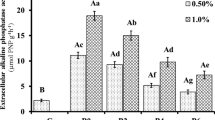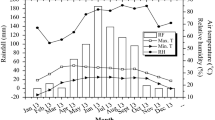Abstract
The most intensive degradation of polysaccharides takes place upon low and moderate temperatures in typical chernozems and gray forest soils and upon high temperatures in brown desert-steppe soils. This regularity is related to the structure of soil microbial complexes. The soil water content exerts a more pronounced effect on chitin decomposition in comparison with cellulose and pectin decomposition. The most favorable conditions for pectin decomposition by microbes are created at the water content close to the field capacity. Model experiments indicate that the range of moisture, upon which the transformation of chitin by microbes is most active, is wider in clay and loamy soils than in sandy soils. Direct study of microorganisms in the investigated soils under microscope has shown that actinomycetes, bacteria, and fungi participate in the transformation of polysaccharides. The role of actinomycetes in chitin decomposition increases in parallel with the rise in the soil water content and temperature. The role of fungi in pectin decomposition becomes higher under higher moistening and lower temperatures. The use of the FISH method makes it possible to reveal differences in the structure and number of metabolically active representatives of Bacteria and Archaea chitinolytic and pectinolytic prokaryotic complexes in the investigated soils under the impact of different ecological factors.
Similar content being viewed by others
References
D. Dorzhgotov, Soils of Mongolia, (Admon, Ulan-Bator, 2003), 287 pp. [in Russian].
D. G. Zvyagintsev and G. M. Zenova, Ecology of Actinomycetes (GEOS, Moscow, 2001) [in Russian].
Methods of Soil Microbiology and Biochemistry (Izd-vo Mosk. Gos. Univ., Moscow, 1991), 303 pp. [in Russian].
T. A. Pankratov, S. E. Belova, and S. N. Dedysh, “Assessment of the Phylogenetic Diversity of Prokaryotic Microorganisms in Sphagnum Bogs with the Use of FISH Method,” Mikrobiologiya 74(6), 831–837 (2005).
L. M. Polyanskaya, Extended Abstract of Doctoral Dissertation in Biology (Mosk. Gos. Univ., Moscow, 1996).
L. L. Shishov, V. D. Tonkonogov, I. I. Lebedeva, and M. I. Gerasimova, Classification and Diagnostic System of Russian Soils (Oikumena, Smolensk, 2004), 342 pp. [in Russian].
R. I. Amann, W. Ludwig, and K.-H. Schleifer, “Phylogenetic Identification and in Situ Detection of Individual Microbial Cells Without Cultivation,” Microbiol. Rev. 59, 143–169 (1995).
R. I. Amann and W. Ludwig, “Ribosomal RNA-Targeted Nucleic Acid Probes for Studies in Microbial Ecology,” FEMS Microbiol. Rev. 24, 555–565 (2000).
S. N. Dedysh, T. A. Pankratov, S. E. Belova, et al., “Phylogenetic Analysis and in situ Identification of Bacteria Community Composition in an Acidic Sphagnum Peat Bog,” Appl. Envir. Microbiol. 72(3), 2110–2117 (2006).
D. L. Kirchman, “The Ecology of Cytophaga-Flavobacteria in Aquatic Environments,” FEMS Microbiol. Ecol. 39, 91–100 (2002).
K. E. B. Knudsen, Carbohydrate and Lignin Contents of Plant Materials Used in Animal Feeding, Animal Feed Technol., 67, 319–338 (1997).
W. Manz, R. Amann, W. Ludwig, et al., “Application of a Suite of 16S RRNA-Specific Oligonucleotide Probes Designed to Investigate Bacteria of the Phylum Cytophaga-Flavobacter-Bacteroides in the Natural Environment,” Microbiology 142, 1097–1106 (1996).
J. A. Parcham and S. P. Deng, “Detection, Quantification of β-Glucosaminidase Activity in Soil,” Soil Biol. Biochem. 32, 1183–1190 (2000).
A. M. Pourcher, L. Sutra, I. Hebe, et al., “Enumeration and Characterization of Cellulolytic Bacteria from Refuse of a Landfill,” FEMS Microbiol. Ecology 34, 229–241 (2001).
S. N. Zelentski and T. A. Akopova, “Solid State Modification of Polysaccharides under Conditions of Plastic Flow,” Polym. Degrad. Stab. 73, 557 (2001).
Author information
Authors and Affiliations
Rights and permissions
About this article
Cite this article
Manucharova, N.A. The microbial destruction of chitin, pectin, and cellulose in soils. Eurasian Soil Sc. 42, 1526–1532 (2009). https://doi.org/10.1134/S1064229309130146
Received:
Published:
Issue Date:
DOI: https://doi.org/10.1134/S1064229309130146




